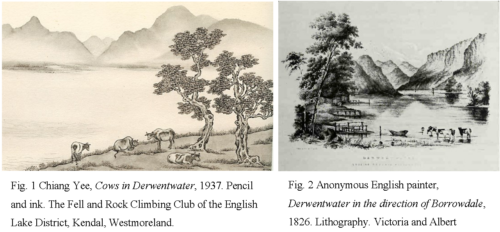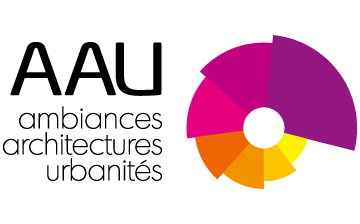La représentation numérique des ambiances. Comparaison entre l’Europe et la Chine
CG Representation of Ambiance The Comparison between Europe and China
Yang Lu - Thèse de doctorat soutenue en 2022
Encadrement : Directeur de thèse Laurent Lescop AAU-CRENAU, encadrant Johannes Kalvelage Ecole d'architecture de Dessau (Allemagne)
Financement : allocation de recherche MENSR
FR
La notion d’ambiance est un concept lié à une esthétique de la phénoménologie. Elle est définie par la perception partagée d’un espace donné. Toutefois cette perception est profondément ancrée dans la culture de chacun comme le montre la représentation du paysage de Derwentwater réalisée par un artiste chinois et un artiste anglais.
 E.H. Gombrich suggère que ces différences sont renforcées par ce qu’Emile Zola appelle le tempérament. L’artiste vient alors choisir des solutions graphiques au sein de conventions culturelles qu’il transforme et qui enrichiront à terme les modèles de représentation.
E.H. Gombrich suggère que ces différences sont renforcées par ce qu’Emile Zola appelle le tempérament. L’artiste vient alors choisir des solutions graphiques au sein de conventions culturelles qu’il transforme et qui enrichiront à terme les modèles de représentation.
La question est désormais de savoir si le tempérament de l’artiste et si l’origine culturelle de la production peuvent être perçus dans une production d’images numériques réputées impersonnelles et standardisées. Cela pose la double question de la représentation des ambiances et de la réception des images par le public.
Ce travail cherche à explorer et discuter ces points de façon multidisciplinaire. Dans un premier temps, il va s’agir d’une comparaison trans-culturelle qui fondera les conditions théoriques pour la comparaison entre les cultures européennes et chinoises. Cela permettra d’identifier le Yi-Jing, comme point de référence pour comprendre la notion d’ambiance dans l’esthétique chinoise classique. Cela sera ensuite comparé avec les théories actuelles développées en Europe.
Ensuite, dans un second temps, seront identifiés les éléments de tempérament qui influencent la production venant des cultures chinoises et européennes, ce particulièrement pour la peinture du paysage. Il s’agira de vérifier si des motifs similaires émergent.
En troisième point, l’exploration du corpus chinois et européen d’images numériques permettra d’identifier des solutions dans la figuration des ambiances qui ont été mobilisées pour restituer des ambiances. Ces solutions seront évaluées sous la forme d’une enquête. Parmi les solutions identifiés et reconnues par l’enquête dans le corpus, deux d’entre elles seront étudiées plus en détails pour comprendre comment elles peuvent être mobilisées pour leur transcription dans une image numérique.
Finalement, une nouvelle évaluation sera proposée auprès d’un public plus large pour tenter de valider les hypothèses avancées au point précédent.
Les résultats de la recherché seront discutés dans un cadre plus général dans la perspective de recommandations pour la transcription numérique des ambiances et plus généralement de considérer leur utilisation dans le cadre de projets ou d’études liées aux questions du patrimoine et de la restauration des sites anciens.
EN
The notion of ambiance is a concept linked to an aesthetics of phenomenology. It is defined by the shared perception of a given space. However, this perception is deeply rooted in the culture. In two representations of Derwentwater respectively realized by a Chinese artist and an English artist, two distinct different ambiances emerged.
E. H. Gombrich believes that these differences are reinforced by what Emile Zola calls the temperament. Affected by it, artist tends to choose graphic solutions he transforms from cultural convention, which will enrich the models of representation for a long term.
Now the question is whether the temperament of the artist and the cultural origin of production can be perceived in the production of CG (Computer Generated) images which are deemed impersonal and standardized. This poses the double question of the representation of ambiance and the reception of images by the public.
This work seeks to explore and discuss these issues in a multidisciplinary method.
In the first step, a trans-cultural study will build a theoretical precondition for the comparison of representation between European and Chinese cultures. This will make it possible to identify the Yi-Jing as a point of reference for understanding the notion of ambiance in classical Chinese aesthetics, and then compare it with current theories of ambiance developed in Europe.
In the second step, the elements of temperament and cultural origin that influence the representations coming from the Chinese and European culture will be identified, especially the ones in the landscape painting. And then the emerging different graphic solutions contributed by these elements will be analyzed through a comparative study.
In the third point, the exploration of the current Chinese and European corpus of CG images will enable it to identify the graphic solutions which have been mobilized to restore ambiances in the CG images. These solutions will be evaluated in the form of a survey. Among these identified and evaluated solutions, two of them will be studied in depth to understand how they are mobilized for their transcription in a CG image.
Finally, a new evaluation will be proposed to a wider audience so as to validate the assumptions that put forward in the previous point.
Research results will be discussed in a more general framework to propose some recommendations for the CG transcription of ambiance and more generally to discuss their usages in the projects or studies related to the restoration of heritage and ancient site.
